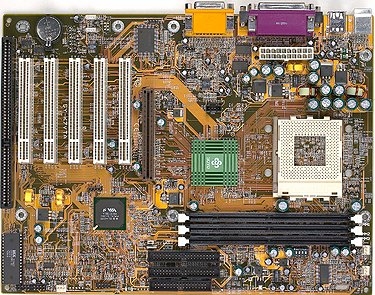 In the wake of the popularity
of the Athlon/Duron platform, Soyo has released 2 Socket A boards of their own:
the SY K7VTA B and the SY K7VTA. Soyo Europe was kind enough to provide us with
both of them. These two boards look quite similar, but they do have some
significant differences in feature set.
In the wake of the popularity
of the Athlon/Duron platform, Soyo has released 2 Socket A boards of their own:
the SY K7VTA B and the SY K7VTA. Soyo Europe was kind enough to provide us with
both of them. These two boards look quite similar, but they do have some
significant differences in feature set.
The early SY K7VTA is equipped with VIA's older southbridge (82C686A),
which supports up a hard disk transfer mode of ATA 66, whereas the SY K7VTA B
has the latest ATA 100 capable southbridge (82C686B). One particular enhancement
of the K7VTA B is the presence of multiplier DIP switches. This is important
addition that makes this product a very attractive choice for overclockers and
enthusiasts.
In this review we are going to
focus on the K7VTA, as we are working on a separate review on the "B"
revision.
First Impressions
Our Soyo K7VTA
sample contained the following material.
One ATA 66/100 cable & FDD
cable
Printed manual
One CD with motherboard drivers, including a full
version of the manual in PDF format and a system monitoring utility
3 in 1
bonus pack CD including: Symantec Norton Antivirus, Norton Ghost & Norton
Virtual Drive
Our sample board is equipped with a chipset heatsink and
had a printed manual. Interestingly enough, according to the manual (PDF
version), this board was based upon a pilot run. Just a small fact that we feel
worthy of mention.
The K7VTA's layout looks to be very well designed as
all sockets, headers, etc. are where they should be. The adjacent space layout
around the CPU socket seems ample enough to handle a pretty big fan/heatsink
combo. As a matter of fact, there are 4 holes around the CPU socket for proper
cooling by way of custom design heatsinks. The K7VTA offers a sufficient amount
of cooling options by providing for 3 fan headers with each of them properly
monitored in the system BIOS.
DIMM slots on the K7VTA are situated above
the lower end of the AGP socket by about 1/2 inch. The benefit of such placement
allows for memory to be in/unstalled without having to remove the AGP video card
first. In some small ATX cases, the outermost DIMM socket might be rendered
useable as it is a bit too close to the back of a CD ROM unit. All IDE/FDD
connectors are easily within reach and all slots can handle full sized add in
cards. To contribute to the cause of system stability, the K7VTA is equipped
with 13 x 1500µF and 15 x 1000µF capacitors. Overall, a well designed
board.
No problems to
report here. The K7VTA setups up pretty quickly and smoothly. If you wish to
start overclocking out of the box, there are BIOS FSB and CPU core voltage
settings to allow for this. Other than that, Windows 98 installed smoothly with
no problems apparent.
Testbed
Setup
AMD Duron 600 MHz
Tested boards: DFI AK74 EC (KT 133,
ATA 100), DFI AK74 AC (KT 133A, ATA 100), Soyo K7VTA B (KT 133,ATA 100) and Soyo
K7VTA (KT 133, ATA 100) paired with VIA 4 in 1 drivers 4.25a
128MB PC 133
CAS 2 SDRAM
ELSA Erazor (Nvidia Geforce 256 DDR), Detonator 6.31
Western Digital 30GB ATA 66 hard drive, 5400rpm (WD307AA)
Labway Xwave 6000
(sound card based on Yamaha 744b), 2013 drivers
NEC 5500A DVDrom
(8x/40x)
BIOS settings on all of the tested boards were tweaked for
maximum performance (HCLK+33, CAS 2, Bank interleave, etc). Do note that Quake3
scores were taken with sound enabled.

